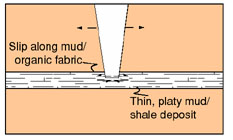![]()
 |
The contrasting material properties of alternating chalk and shale layers control vertical connectivity of fractures within the Austin Chalk, Texas. Within exposures of the Austin Chalk and core, we observe that the majority of vertical fractures occur in chalk layers and abut against contacts with shale layers. Whether fractures abut against or propagate through shale layers may significantly influence vertical flow of subsurface fluids; vertical flow is inhibited when fractures are contained within chalk layers but promoted when fractures cross shale layers. Our field observations indicate that thicker shale layers resist fracture propagation more than thinner shale layers. From this observation we hypothesize that as vertical fractures develop within horizontal chalk layers, both the resistance of shale to fracturing and the thickness of bounding shale layers may prevent these fractures from propagating across the bounding shale and into the next chalk layers. Thus, models for investigating fracture termination at shale layers must include thickness of the shale layers. |
We model propagation of a crack within a three-layered system (chalk:shale:chalk) (brittle:fracture resistant:brittle) following the crack-bridging analysis of the engineering composites literature. The modeled crack extends across the shale of the chalk:shale:chalk system, but closing tractions are applied to the portion of the crack within the shale layer to simulate the resistance of shale to fracturing. The tip of the crack lies a short distance within the unfractured chalk layer simulating a flaw with potential to propagate. The modeled crack simulates a coplanar flaw and fracture within two chalk beds separated by unfractured shale; in this manner, the fracture bridges the shale unit. If the stress intensity factor at the flaw tip exceeds the fracture toughness of chalk, the crack propagates and eventually may connect the two chalk layers. If the stress intensity factor at the flaw is lower than the fracture toughness of the chalk, the fracture arrests at the shale layer and the two chalk layers on either side of the shale remain separate flow units. This crack bridging analysis shows that fracture propagation depends on thickness of layers. For a given chalk thickness, there is a critical shale thickness above which fractures cross the shale layer and below which fractures arrest at shale. Thicker chalk layers are more likely to produce fractures which cross shale layers and enhance vertical connectivity whereas thicker shale layers promote fracture termination.
We use Finite Element Method (FEM) analysis to evaluate the incorporation of ductile properties to the shale layers within the chalk:shale:chalk system. We found that when ductile properties are prescribed to shale, fluid pressure driven fractures have greater stress intensity factor than fractures under remote tension. Thus, lower driving stresses are required to propagate fluid pressure driven fractures through a system of brittle chalk and ductile shale layers than fractures under remote tension. For a linear elastic chalk/shale systems, remote and pore pressure driven fractures produce identical stress intensity factors.
This material is based upon work partially supported by the National Science Foundation under Grant No. 9996296.